
Philip Ligon’s love of fantasy began in earnest when he tried to read The Sword of Shannara for a book report in high school. Though he had to choose a different book for the report, he was forever hooked on epic adventures, quests, and fantastic realms. He proceeded to read every Terry Brooks book he could find, and soon discovered the works of Raymond Feist, Michael Moorcock, and threw in a heavy dose of Orson Scott Card, to name a few. He has received numerous awards for his works, including being a multi-year finalist in the Paul Gillette Writing Contest and a finalist in Colorado Gold. This Strange Engine was a finalist in the 2015 Zebulon writing contest and a quarterfinalist in the 2014 ABNA.
The first two books in his Steampunk series are This Strange Engine and This Mysterious Engine.
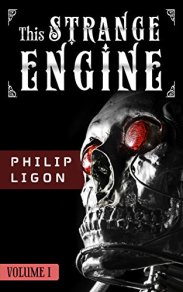 Thief. Pauper. Magic addict. Alexander Asherton, Ash to his friends, has reached the low point of his life. A once promising future with the Church of England has given way to a clandestine organization which tracks and collects magical items. They provide the elixirs that keep Ash alive, and in exchange he uses the power the elixirs grant to ‘acquire’ what they desire. If he succeeds, he lives. If he fails, he dies. The arrangement is simple enough… until his latest assignment becomes personal: recover an item in the possession of his former wife, Aimee. Ash’s world becomes even darker and stranger as he is drawn into a past he had hoped to leave behind.
Thief. Pauper. Magic addict. Alexander Asherton, Ash to his friends, has reached the low point of his life. A once promising future with the Church of England has given way to a clandestine organization which tracks and collects magical items. They provide the elixirs that keep Ash alive, and in exchange he uses the power the elixirs grant to ‘acquire’ what they desire. If he succeeds, he lives. If he fails, he dies. The arrangement is simple enough… until his latest assignment becomes personal: recover an item in the possession of his former wife, Aimee. Ash’s world becomes even darker and stranger as he is drawn into a past he had hoped to leave behind.
 Love. Betrayal. Revenge. Problems are growing worse for Ash. To save Sheela, the woman he loves, he had no choice but to betray her greatest secret. As a result, she was taken prisoner by Duke Schaever, the man who controls the flow of magic into the English Empire. Although Ash has tried to rescue Sheela, failure after failure has made him desperate enough to accept a new mission from his employers that will strike Duke Schaever at the most personal of levels – by kidnapping Lady Elizabeth Stewart, the Duke’s betrothed. It is an assignment fraught with danger, and as Ash moves closer to his goal, he is pulled deeper into the Duke’s world – a place that reveals the abominations of magic and science, that gives rise to new enemies, and where Ash learns exactly what motivates the Duke. The discoveries test friendships, love, and loyalties, even as it forces Ash to question what it means to live. And what it means to die.
Love. Betrayal. Revenge. Problems are growing worse for Ash. To save Sheela, the woman he loves, he had no choice but to betray her greatest secret. As a result, she was taken prisoner by Duke Schaever, the man who controls the flow of magic into the English Empire. Although Ash has tried to rescue Sheela, failure after failure has made him desperate enough to accept a new mission from his employers that will strike Duke Schaever at the most personal of levels – by kidnapping Lady Elizabeth Stewart, the Duke’s betrothed. It is an assignment fraught with danger, and as Ash moves closer to his goal, he is pulled deeper into the Duke’s world – a place that reveals the abominations of magic and science, that gives rise to new enemies, and where Ash learns exactly what motivates the Duke. The discoveries test friendships, love, and loyalties, even as it forces Ash to question what it means to live. And what it means to die.
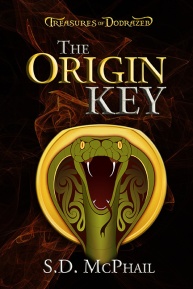 My novel Treasures of Dodrazeb: The Origin Key is an historical sword-and-science fantasy adventure. Click here to read an excerpt.
My novel Treasures of Dodrazeb: The Origin Key is an historical sword-and-science fantasy adventure. Click here to read an excerpt.
An invading Persian warrior becomes obsessed with Dodrazeb, a strange isolated kingdom that possesses incredible technology. Ancient Dodrazeb’s puzzling choice to hide from the world pulls him deeper into layers of mysteries as its sly princess does everything she can to expel the invaders. What are the Dodrazebbians so desperate to keep hidden?
Get your copy on Amazon.com! Available in both e-book and paperback.
Q. You’ve taken steampunk to a whole new level with this series! Please tell us briefly about the steampunk genre.
Steampunk is an interesting genre because it has been with us for a long time – from the works of Jules Verne and H.G. Wells to Michael Moorcock – yet has begun to really come into its own in the last 10 years or so. I like to describe it as the Industrial Revolution on steroids, where steam-powered technology advances to the point where it is the primary source of energy. And it powers everything from lights to airships to robots. The setting is typically associated with the Victorian era, though many writers have expanded it to different time periods and to different parts of the world.
Q. Tell us about your book series and why you chose to write steampunk.
The Engine Series follows the (mis)adventures of Alexander Asherton who tries to piece together a broken life. It takes place in 1860s England, in a town called Campden, which serves as a crossroads of science and magic, due to a portal – the Gateway – having been opened there. The Gateway leads to a mysterious world full of elves, dwarves, orcs, dragons, gnomes, and other magical creatures. The introduction of magic to a world with advanced steam technology creates new opportunities for those willing to exploit the possibilities of strange, new powers. One such person is Duke Schaever, who is determined to combine science and magic for his own ends. Unfortunately for Ash, he is drawn into the Duke’s schemes…and what he discovers are secrets far darker than anything he could have imagined.
As far as why I chose to write steampunk, I have to say it is primarily because the genre offers many futuristic ideas set in historical settings with alternate timelines and histories…there are lots of possibilities to be explored and lots of stories begging to be put onto paper.
Q. Alexander Asherton is a complicated, driven character. What do you like most—and least—about him?
Ash, as his friends call him, has a lot of admirable qualities. He wants to do the right thing. He has a special fondness for those in need, especially women and children. He is fiercely loyal to his friends. At the same time, he struggles with life. Yet he tends to be obsessive, especially when it comes to affairs of the heart. He wants to see the good in people even when they prove over and over again that they are anything but. And he is hard on himself for his past mistakes.
Q. Without giving away too much, what can you tell us about your story’s villains?
The villains are driven, determined, and know what they want. They will stop at nothing, and will let no one get in there way. Of course, that begs another question – why are they so driven? For that answer, well…you have to read the books!
Q. What’s different or unique about your story from other steampunk works?
This series is different because it is not a pure steampunk work. In fact, it contains a lot of fantasy elements, and magic plays an essential role in everything that happens. Part of the overall story is about the implications of what happens when technology and magic are merged. Good things? Bad things? A little bit of both?
Q. What kind of research did you do for this story?
Being set in the time that it’s in, I had to do a lot of research on the Victorian era. What type of clothing did they wear? How did the language differ? What terms did they use? What was life like in that time? Those are just some of the questions I had to answer…and I learned a lot more about Victorian dress and socially acceptable etiquette than I ever thought I would know!
Q. Which works and authors would you say influenced the book? How?
Being a story set in Victorian England, and being a fan of his work, I would say Charles Dickens had a bit of influence on the series. His works capture so much of the essence of the era – from the social structure to the political influences to the language.
Q. What was your favorite scene to write?
In both books, there are so many scenes I enjoyed writing, it’s hard to choose! But for the first book, I’ll go with the Duke’s Ball. It was fun trying to describe the other-worldly nature of the grand event. Here is a man who is known for his extravagances and this is the one time of the year that he goes above and beyond anything else, and puts it on display for the entire town to see. For the second book, I’ll go with the finale at Chen’s Dragon Theatre. I won’t go into detail on it, lest I give too much away…but there are vital decisions that Ash must make against a backdrop of very dangerous magic and science.
Q. What was the hardest part of the book for you to write?
The hardest part of both books has been the language – how to keep the tone and formality of the Victorian era while writing with a modern style. There is a balance between the two that demanded a lot of attention.
Q. Do you have plans for more books in this series? Are you interested in expanding into other genres?
I’m currently working on the third book, so yes, there will be at least one more. Beyond that? We’ll see. There could be more stories left to be told with the characters.
I’m definitely going to expand to other genres, particularly Fantasy. Considering there is so much Fantasy in the Engine series, though, that might not necessarily count as expanding into another genre.
And while it’s not a genre per se, I’m also wrapping up work on a middle-grade Steampunk book. There are definite differences in writing for an adult audience and a middle-grade audience.
Q. What made you decide to get serious about writing? How long were you “dabbling” before you felt the time was right to publish your work?
I’ve been at this writing stuff a long time…over twenty years. Throughout that time, I queried countless agents and editors, and attended various conventions where I met agents and editors, all in the hopes of attracting attention. Along the way, something funny happened…self-publishing really evolved into a viable option. It really got to the point where I could spend more years continuing the query and submission process, or I could do it myself. So I decided to give it a try.
Q. A lot of writers seem to despise the editing process. Do you like it or hate it? How do you approach the task of editing?
Editing is a love-hate relationship. Ernest Hemingway said it best: ‘The only kind of writing is rewriting.’ There is a lot of truth in that. Writing the first draft can be a journey of discovery that is fun and enthralling. Yet rewriting – what I’m calling editing in this context – is where the author really gets to shape the story and the characters. It’s not always fun to work through your book for the fifth, or sixth, or seventh time, but it must be done if you want to make the book as good as it can be. It’s a lot like the sculptor shaping and smoothing and polishing until a statue is finished.
Q. Most of us authors don’t make enough money from writing – yet – to pay the bills. Do you have a job other than writing?
My undergraduate degree is in Mechanical Engineering (and maybe that’s where the interest in Steampunk really comes from), so I work as an engineer during the day.
Q. When you aren’t crafting amazing stories, what do you do for fun?
I enjoy watching movies and reading.
Q. What advice do you have for writers who want to become published authors?
Unless you are a rare writer who becomes published almost from the start, you have to have perseverance more than anything else. You also need a willingness to learn and grow as a writer.
Q. Is there anything about the writing life that you think is misunderstood by the public?
Writing is tough. Filling up page after page of white with all of these words can take a long time. And it is lonely work.
Q. As a reader, what about a book turns you away?
Bad writing and bad characters, though those often go together. By bad characters, I mean ones who are not believable or are undeveloped or are unsympathetic.
Q. What’s your all-time favorite book? Why?
This is another tough question. There are so, so many good books. Since I’ve already mentioned Dickens, I’ll have to go with Great Expectations (Where the Red Fern Grows by Wilson Rawls is a close second). Pip and Estella are such dynamic characters. And the fact that Pip works so hard to make something of himself so he can prove his worth to the girl he’s loved since the first time they met brings a quiet desperation to the entire story that grips the reader. It’s Dickens at his best.
Q. What’s your all-time favorite TV show? Why?
MASH. The show is full of different characters and a cast that goes through so many changes. One episode will make you laugh until you cry. The next will make you cry because it’s sad. There is such a variety of stories for such a small setting. I never get tired of watching the show.
Q. What’s your all-time favorite movie? Why?
Casablanca. Action, adventure, romance, bravery, deceit…what more do you need in a movie? It’s a great story with even greater actors giving some of their best performances.
If there’s a theme in these answers to favorite book and TV show and movie…it’s all about the characters. They are the heart and soul of everything that happens. And that’s something that any writer should keep in mind.
Contact Information:
Author Name: Philip Ligon
Blog: www.philipligon.com
Goodreads: <https://www.goodreads.com/author/show/15283152.Philip_Ligon
Book Links: This Strange Engine This Mysterious Engine
 Treasures of Dodrazeb: The Origin Key is an historical sword-and-science fantasy adventure. Click here to read an excerpt.
Treasures of Dodrazeb: The Origin Key is an historical sword-and-science fantasy adventure. Click here to read an excerpt.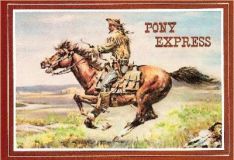 Even though it set speed records for mail delivery and became a well-loved and thoroughly romanticized piece of historical lore, the Pony Express was only in operation for 19 months. In that brief time, it failed to secure a lucrative government mail contract and never turned a profit. Between hostile Native Americans and the completion of the transcontinental telegraph system, the Pony Express was driven out of business and became obsolete in October of 1861.
Even though it set speed records for mail delivery and became a well-loved and thoroughly romanticized piece of historical lore, the Pony Express was only in operation for 19 months. In that brief time, it failed to secure a lucrative government mail contract and never turned a profit. Between hostile Native Americans and the completion of the transcontinental telegraph system, the Pony Express was driven out of business and became obsolete in October of 1861. So, just how did that famous phrase come to be associated with the U.S. Postal Service? The unofficial motto is inscribed in granite over the entrance of the James A. Farley building at Eighth Avenue and 33rd Street in New York City, right in the middle of Manhattan. Back in the early twentieth century, the architectural firm of McKim, Mead & White was chosen to design the New York General Post Office building. Construction began in 1912 and it was opened to the public in 1914. The building was doubled in size in 1934 and its name was changed to honor Postmaster General James A. Farley.
So, just how did that famous phrase come to be associated with the U.S. Postal Service? The unofficial motto is inscribed in granite over the entrance of the James A. Farley building at Eighth Avenue and 33rd Street in New York City, right in the middle of Manhattan. Back in the early twentieth century, the architectural firm of McKim, Mead & White was chosen to design the New York General Post Office building. Construction began in 1912 and it was opened to the public in 1914. The building was doubled in size in 1934 and its name was changed to honor Postmaster General James A. Farley. William Mitchell Kendall was one of the architects. Kendall, who frequently read classic Greek literature for pleasure, had grown up in a wealthy household with a father who was a scholar of the classics. He selected a passage (translated by Professor George Herbert Palmer of Harvard University) from book 8, paragraph 98, of The Persian Wars by the ancient Greek historian Herodotus (c 484–c 425 BCE). The Post Office Department agreed that Kendall’s slight modification of the original translation was suitable for the building, and approved it.
William Mitchell Kendall was one of the architects. Kendall, who frequently read classic Greek literature for pleasure, had grown up in a wealthy household with a father who was a scholar of the classics. He selected a passage (translated by Professor George Herbert Palmer of Harvard University) from book 8, paragraph 98, of The Persian Wars by the ancient Greek historian Herodotus (c 484–c 425 BCE). The Post Office Department agreed that Kendall’s slight modification of the original translation was suitable for the building, and approved it.

 Thief. Pauper. Magic addict. Alexander Asherton, Ash to his friends, has reached the low point of his life. A once promising future with the Church of England has given way to a clandestine organization which tracks and collects magical items. They provide the elixirs that keep Ash alive, and in exchange he uses the power the elixirs grant to ‘acquire’ what they desire. If he succeeds, he lives. If he fails, he dies. The arrangement is simple enough… until his latest assignment becomes personal: recover an item in the possession of his former wife, Aimee. Ash’s world becomes even darker and stranger as he is drawn into a past he had hoped to leave behind.
Thief. Pauper. Magic addict. Alexander Asherton, Ash to his friends, has reached the low point of his life. A once promising future with the Church of England has given way to a clandestine organization which tracks and collects magical items. They provide the elixirs that keep Ash alive, and in exchange he uses the power the elixirs grant to ‘acquire’ what they desire. If he succeeds, he lives. If he fails, he dies. The arrangement is simple enough… until his latest assignment becomes personal: recover an item in the possession of his former wife, Aimee. Ash’s world becomes even darker and stranger as he is drawn into a past he had hoped to leave behind. Love. Betrayal. Revenge. Problems are growing worse for Ash. To save Sheela, the woman he loves, he had no choice but to betray her greatest secret. As a result, she was taken prisoner by Duke Schaever, the man who controls the flow of magic into the English Empire. Although Ash has tried to rescue Sheela, failure after failure has made him desperate enough to accept a new mission from his employers that will strike Duke Schaever at the most personal of levels – by kidnapping Lady Elizabeth Stewart, the Duke’s betrothed. It is an assignment fraught with danger, and as Ash moves closer to his goal, he is pulled deeper into the Duke’s world – a place that reveals the abominations of magic and science, that gives rise to new enemies, and where Ash learns exactly what motivates the Duke. The discoveries test friendships, love, and loyalties, even as it forces Ash to question what it means to live. And what it means to die.
Love. Betrayal. Revenge. Problems are growing worse for Ash. To save Sheela, the woman he loves, he had no choice but to betray her greatest secret. As a result, she was taken prisoner by Duke Schaever, the man who controls the flow of magic into the English Empire. Although Ash has tried to rescue Sheela, failure after failure has made him desperate enough to accept a new mission from his employers that will strike Duke Schaever at the most personal of levels – by kidnapping Lady Elizabeth Stewart, the Duke’s betrothed. It is an assignment fraught with danger, and as Ash moves closer to his goal, he is pulled deeper into the Duke’s world – a place that reveals the abominations of magic and science, that gives rise to new enemies, and where Ash learns exactly what motivates the Duke. The discoveries test friendships, love, and loyalties, even as it forces Ash to question what it means to live. And what it means to die. My novel
My novel  When Plato wrote about a utopian island kingdom as an allegorical tale, he had no idea that our modern pop culture would become riddled with references to the “lost continent of Atlantis” thousands of years later. The idea that Atlantis might have been a real place that collapsed into the sea at the height of its power and influence has captured the modern imagination—and kept it in a chokehold for generations.
When Plato wrote about a utopian island kingdom as an allegorical tale, he had no idea that our modern pop culture would become riddled with references to the “lost continent of Atlantis” thousands of years later. The idea that Atlantis might have been a real place that collapsed into the sea at the height of its power and influence has captured the modern imagination—and kept it in a chokehold for generations. Another legendary city known for its lavish architecture and utopian lifestyle is Dwarka, translated as “Gateway to Heaven” in Sanskrit. According to the ancient Hindu Mahabharata texts, Dwarka was founded by Krishna, the blue Hindu god of compassion, tenderness, and love. The city is described as having 900,000 royal palaces, all made of crystal and silver and decorated with emeralds. It featured an elaborate system of boulevards, roads, market places, assembly houses, and temples. The ancient texts describe how the evil King Salva declared war and attacked Dwarka with a flying machine using lightning-like energy weapons. Lord Krishna counterattacked, firing his weapons described as arrows “roaring like thunder and shining like the rays of the sun.” Their devastating battle left most of the city in ruins.
Another legendary city known for its lavish architecture and utopian lifestyle is Dwarka, translated as “Gateway to Heaven” in Sanskrit. According to the ancient Hindu Mahabharata texts, Dwarka was founded by Krishna, the blue Hindu god of compassion, tenderness, and love. The city is described as having 900,000 royal palaces, all made of crystal and silver and decorated with emeralds. It featured an elaborate system of boulevards, roads, market places, assembly houses, and temples. The ancient texts describe how the evil King Salva declared war and attacked Dwarka with a flying machine using lightning-like energy weapons. Lord Krishna counterattacked, firing his weapons described as arrows “roaring like thunder and shining like the rays of the sun.” Their devastating battle left most of the city in ruins. Until recently the very existence of Dwarka was thought by many to be merely legend. In 2001 the Indian government recovered materials from an underwater archaeological site in the Gulf of Khambhat. Pottery, sections of walls, beads, sculpture, and human bones and teeth from the site were carbon dated and found to be nearly 9,500 years old. Marine archaeologists have mapped sandstone walls, street grids, and remains of a busy and important seaport at 70 feet under water.
Until recently the very existence of Dwarka was thought by many to be merely legend. In 2001 the Indian government recovered materials from an underwater archaeological site in the Gulf of Khambhat. Pottery, sections of walls, beads, sculpture, and human bones and teeth from the site were carbon dated and found to be nearly 9,500 years old. Marine archaeologists have mapped sandstone walls, street grids, and remains of a busy and important seaport at 70 feet under water.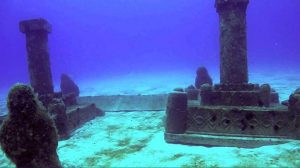 What has been investigated so far corresponds closely to descriptions of Dwarka in the Mahabharata. Many semicircular, rectangular, and square stone structures, as well as stone anchors have been documented, indicating a thriving overseas trade coming through this port city on the west coast of India. Scientists believe the area was submerged as ice caps melted at the end of the last ice age nine to ten thousand years ago.
What has been investigated so far corresponds closely to descriptions of Dwarka in the Mahabharata. Many semicircular, rectangular, and square stone structures, as well as stone anchors have been documented, indicating a thriving overseas trade coming through this port city on the west coast of India. Scientists believe the area was submerged as ice caps melted at the end of the last ice age nine to ten thousand years ago.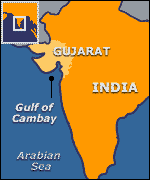 Explorations of the Dwarka site are challenging long-held scientific beliefs. For instance, mainstream science holds that ancient Indian culture goes back some four to five thousand years. Yet these ruins are at least nine thousand years old, dating back to a time when the area submerged under water. The city must have existed before the flooding by centuries—if not by millennia—for it to have grown and expanded to become the bustling seaport that it became.
Explorations of the Dwarka site are challenging long-held scientific beliefs. For instance, mainstream science holds that ancient Indian culture goes back some four to five thousand years. Yet these ruins are at least nine thousand years old, dating back to a time when the area submerged under water. The city must have existed before the flooding by centuries—if not by millennia—for it to have grown and expanded to become the bustling seaport that it became.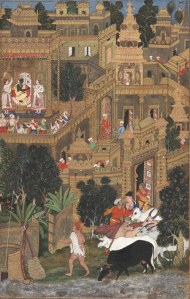 Now that these remains have been discovered under water, there is evidence that the legendary Dwarka did exist. It was a real city populated with living citizens suggesting that Indian civilization may be twice as old as scientists have believed. Whether or not it was also the dwelling place of lord Krishna and his aerial battle with king Salva was an historical occurrence is still a matter of some debate.
Now that these remains have been discovered under water, there is evidence that the legendary Dwarka did exist. It was a real city populated with living citizens suggesting that Indian civilization may be twice as old as scientists have believed. Whether or not it was also the dwelling place of lord Krishna and his aerial battle with king Salva was an historical occurrence is still a matter of some debate. In my sword-and-science fantasy novel The Origin Key, a third-century Persian prince discovers an incredibly ancient society with surprisingly modern science and technology. The prince is not amused when he is told that the revered Persian ruler Cyrus the Great created the Persian Empire with help and advice from Dodrazeb. In the story, Dodrazeb is a fictional kingdom that originated virtually every scientific advancement known to 21st century mankind—plus some still unknown to us.
In my sword-and-science fantasy novel The Origin Key, a third-century Persian prince discovers an incredibly ancient society with surprisingly modern science and technology. The prince is not amused when he is told that the revered Persian ruler Cyrus the Great created the Persian Empire with help and advice from Dodrazeb. In the story, Dodrazeb is a fictional kingdom that originated virtually every scientific advancement known to 21st century mankind—plus some still unknown to us.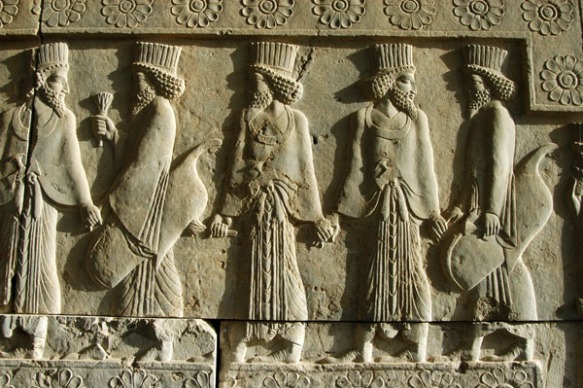
 The
The  The earliest known
The earliest known  Ancient Persians developed ingenious
Ancient Persians developed ingenious  Persians invented “
Persians invented “ Trousers
Trousers